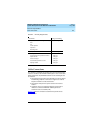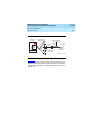
DEFINITY AUDIX System Release 4.0
System Description Pocket Reference
585-300-214
Issue 1
May 1999
Transition Notes
A-5
System Design
information about modem initialization strings, see
Installation and
Switch Administration for the DEFINITY AUDIX System Release 4.0
,
585-300-122.
Alarm Relay
Previous releases of the DEFINITY AUDIX system could use the two-wire
alarm relay to notify INADS of major alarms. Although the DEFINTY
AUDIX system can notify INADS of minor alarms via the external
modem, the system will no longer use the two-wire alarm relay to signal
minor alarms.
For more information about Alarm Origination for DEFINITY AUDIX
system Release 4.0, including self-diagnostics, the external modem,
and the alarm relay, see Chapter 3
.
LEDs
DEFINITY AUDIX system Release 4.0 uses three light-emitting diodes
(LEDs) on its faceplate to display system status and health. Previous
system releases used a liquid crystal display (LCD) for the same
purpose. The LCD used three maintenance buttons and a structured set
of menus to display messages about system status.
The LEDs on Release 4.0 display information similar to the messages on
the old LCD. However, technicians and system administrators cannot
manipulate the LEDs to display different types of messages while the
system is running.
NOTE:
The two recessed maintenance buttons on DEFINTY AUDIX
system Release 4.0 do not perform the same functions as the three
maintenance buttons for the LCD on previous system releases. For
more information about the LEDs and recessed maintenance
buttons on Release 4.0, see Chapter 3
.
MO Disk Drive
DEFINITY AUDIX system Release 4.0 uses a magneto-optical (MO) disk
drive for backups and software upgrades. Previous releases used a
tape drive.
The MO disk drive is smaller than the tape drive, which helps reduce the
system’s demand for space in the customer’s switch. The rewritable
disks for the MO disk drive offer slightly more storage space than the
tapes for the tape drive, as well as flexibility for data access and reuse.
For more information about the MO disk drive, see Chapter 2
, Chapter 3,
and Chapter 3
.


















